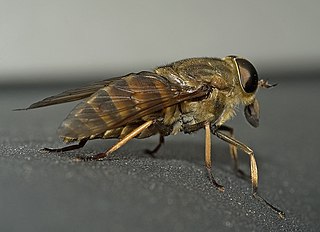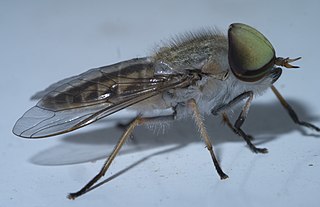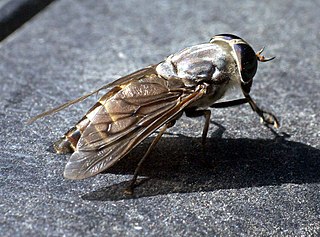
Horse-flies and deer flies are true flies in the family Tabanidae in the insect order Diptera. The adults are often large and agile in flight. Only female horseflies bite land vertebrates, including humans, to obtain blood. They prefer to fly in sunlight, avoiding dark and shady areas, and are inactive at night. They are found all over the world except for some islands and the polar regions. Both horse-flies and botflies (Oestridae) are sometimes referred to as gadflies.

Tabanus nigrovittatus, also known as the greenhead horse fly, salt marsh greenhead, or simply the greenhead fly, greenhead or greenfly, is a species of biting horse-fly commonly found around the coastal marshes and wetlands of the Eastern United States. They are smaller than most horsefly species, instead being close in size to a common housefly. The biting females are a considerable pest to both humans and animals while they seek a source of blood protein to produce additional eggs: greenhead larvae develop in the mud of salt marshes, and adult flies mate and lay their first group of eggs in the marsh, but to lay more eggs a female fly needs to drink an animal's blood, and so female greenheads which have laid eggs fly inland to look for prey in the area bordering the marsh; they can stay on land looking for animals to bite for up to four weeks. Their bites are more painful than those of mosquitoes, since greenheads feed by cutting a wound in the skin with scissor-like mouth parts and sucking the blood released through it. Females live for three to four weeks and may lay about 100 to 200 eggs per blood meal. The eggs are laid on the grass in a salt marsh; the larvae live in the intertidal mud of the salt marsh for one or two years, preying on other invertebrates, before pupating in early spring. The adult flies emerge in late spring and are most common from late June to August.

Tabanus autumnalis, the large marsh horsefly, is a medium-sized species of biting horse-fly. It is somewhat scarce compared to T. bromius and T. bovinus. This species shows slightly more of a preference for coastal marsh than some of the other European Tabanus, sometime even found in saltmashes. Wing length is 13–16 mm and about 16–22 mm in body length.

Tabanus sudeticus, also known as the dark giant horsefly, is a species of biting horse-fly. It is the heaviest fly in Europe.
Tabanus spodopterus also known as the black horned giant horsefly is a species of biting horse-fly. It is widespread in Europe, but only one doubtful specimen has been found in the United Kingdom.
Tabanus darimonti is a Mediterranean species of biting horse-fly. Only female specimens are known.
Cornelius Becker Philip (1900–1987) was an American entomologist, noted for assigning comedic names to species he described.

Tabaninae is a subfamily in the family Tabanidae commonly known as horse flies. There are more than 3000 described species in Tabaninae.
Tabanus novaescotiae is a species of Horse-fly in the family Tabanidae.

Tabanus americanus, the American horse fly, is a species of horse-fly in the family Tabanidae.
Tabanus conterminus is a species of horse fly in the family Tabanidae.
Tabanus petiolatus is a species of horse fly in the family Tabanidae. Unlike many Tabanus species, the colour pattern of male eyes is found in the larger, upper lenses - appearing as a dark, brown streak across the light coloured lens. Females of this species have uniformly coloured dark brown eyes. Often confused with Tabanus melanocerus or Tabanus trimaculatus.
Tabanus nigripes is a species of horse fly in the family Tabanidae.

Tabanus calens is a species of horse fly in the family Tabanidae.
Tabanus marginalis is a species of horse fly in the family Tabanidae.
Tabanus sagax is a species of horse fly in the family Tabanidae.

Tabanus subsimilis is a species of horse fly in the family Tabanidae.

Tabanus punctifer, commonly known as the western horse fly, is a species of horse fly in the family Tabanidae. This species of horse fly is approximately 20.5 mm (0.8 in) long. They are typically found throughout the southern and western parts of the United States. They can be found between Utah and Mexico, and between California and Texas. The thorax is covered with long hairs that give it a creamy white color, while the abdomen is completely black. Much like other horse fly species, the Tabanus punctifer female requires a blood meal for the development of their eggs. Females will bite horses, livestock, and humans, making them vectors of disease for pathogens and parasites.

Tabanus sulcifrons is a species of horse fly in the family Tabanidae.











